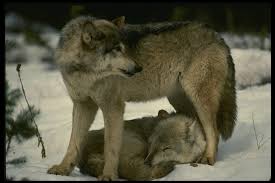Difference between revisions of "Wulfra"
(→Anatomy & Mortality) |
(→Anatomy & Mortality) |
||
| Line 29: | Line 29: | ||
His coat is also well resistant to the harsh climates. The two layer coat keeps out water and dirt, whilst it also leeps the animal warm. The Females keep their winter coat further into spring than the male Wulfras. | His coat is also well resistant to the harsh climates. The two layer coat keeps out water and dirt, whilst it also leeps the animal warm. The Females keep their winter coat further into spring than the male Wulfras. | ||
| − | The tooth configuration is the same as that of the [[Wikipedia:http://en.wikipedia.org/wiki/ | + | The tooth configuration is the same as that of the [[Wikipedia:http://en.wikipedia.org/wiki/Grey_Wolf#Anatomy| Grey Wolf]]: ''The upper jaw has 6 incisors, 2 canines, 8 premolars, and 4 molars. The bottom jaw has 6 incisors, 2 canines, 8 premolars, and 6 molars. The canines are by far most important, as they are used to catch and hold prey. One common reason for wolves to starve is tooth damage after being kicked by larger prey.'' |
There has been an unofficial record of a Wulfra that became 30 years old. But most reach 16 years in the wild and approximately 24 years in captivity. Many pups do not survive the harsh winter. Wulfras have become more vulnerable to diseases over the past few decades. Deforestation and [[Wikipedia:20th Century Sozy|urbanisation]] caused mass-death of many Wulfras, but in the wild Wulfra populations adapt quickly to the amount of preys in their territory. | There has been an unofficial record of a Wulfra that became 30 years old. But most reach 16 years in the wild and approximately 24 years in captivity. Many pups do not survive the harsh winter. Wulfras have become more vulnerable to diseases over the past few decades. Deforestation and [[Wikipedia:20th Century Sozy|urbanisation]] caused mass-death of many Wulfras, but in the wild Wulfra populations adapt quickly to the amount of preys in their territory. | ||
Revision as of 19:06, 10 April 2005
This topic is about the Wulfra, the National Animal of Sozy.
Contents
Classification
| Scientific classification
|
| Kingdom: Animalia |
| Phylum: Chordata |
| Class: Mammalia |
| Order: Carnivora |
| Family: Canidae |
| Genus: Canis |
| Specific Genus: Canis Sozinus |
Anatomy & Mortality
The average Wulfra weighs 60 kg (130 lb), and is about 1 to 1.5 m (40 to 60 in) long with the tail being roughly a third of their body length. The males and females are of the same size, though at birth, the females are slightly bigger. The coloration runs from grey to grey brown, they adapt their hair to the climate, Wulfras in the North of Sozy have white tins, whereas the Wulfras in the forests have dark-grey tints. His eyes have a silver or golden colour, but they can also have one golden and one silver eye.
The Wulfra's body is thin, for high-speed running. The most powerful muscles are in his legs. Their paws are well-adapted to any kind of surface.
His coat is also well resistant to the harsh climates. The two layer coat keeps out water and dirt, whilst it also leeps the animal warm. The Females keep their winter coat further into spring than the male Wulfras.
The tooth configuration is the same as that of the Grey Wolf: The upper jaw has 6 incisors, 2 canines, 8 premolars, and 4 molars. The bottom jaw has 6 incisors, 2 canines, 8 premolars, and 6 molars. The canines are by far most important, as they are used to catch and hold prey. One common reason for wolves to starve is tooth damage after being kicked by larger prey.
There has been an unofficial record of a Wulfra that became 30 years old. But most reach 16 years in the wild and approximately 24 years in captivity. Many pups do not survive the harsh winter. Wulfras have become more vulnerable to diseases over the past few decades. Deforestation and urbanisation caused mass-death of many Wulfras, but in the wild Wulfra populations adapt quickly to the amount of preys in their territory.

